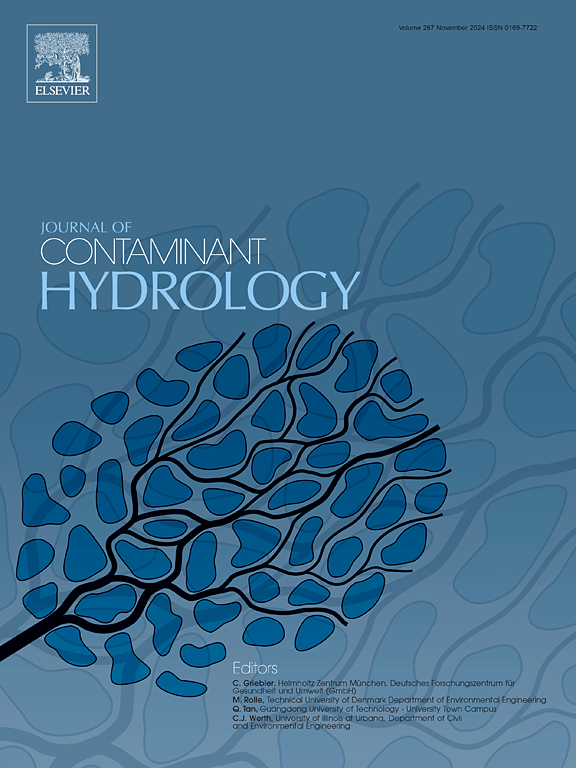砂-粘土混合物的纵向分散性和饱和度:粘土含量、初始饱和度和膨胀势的影响
IF 3.5
3区 环境科学与生态学
Q2 ENVIRONMENTAL SCIENCES
引用次数: 0
摘要
色散在预测溶质在非饱和土壤中的迁移中起着关键作用。因此,本研究采用室内土柱试验对砂-粘土混合料的非饱和纵向分散性进行了全面研究。考察了粘土含量、平均饱和度、流道长度和膨胀势对非饱和纵向分散性的影响。利用平流-色散方程对观测到的突破曲线进行纵向色散评价。研究发现,伊利石含量、初始饱和度、流道长度和膨胀势的增加导致了纵向分散性的增加。此外,饱和条件下的纵向色散比初始平均饱和度为80%时低,而非饱和条件下纵向色散随初始饱和度从20%增加到80%而增加。这一观察结果导致纵向色散的双线性趋势,作为砂-粘土混合物中初始饱和度的函数。本研究中观察到的砂-粘土混合物纵向分散性的趋势与砂的文献报道不同,这表明在预测含粘土土壤的非饱和纵向分散性时,需要考虑粘土含量、膨胀势和初始饱和度。本文章由计算机程序翻译,如有差异,请以英文原文为准。
Longitudinal dispersivity and saturation of sand-clay mixtures: Impact of clay content, initial degree of saturation, and swelling potential
Dispersion plays a critical role in predicting solute transport through unsaturated soils. Therefore, this study comprehensively investigated the unsaturated longitudinal dispersivity of sand-clay mixtures using laboratory soil-column experiments. The effects of clay content, average degree of saturation, flow path length, and swelling potential on the unsaturated longitudinal dispersivity were examined. The longitudinal dispersivity was evaluated based on the observed breakthrough curves using the advection-dispersion equation. It was found that an increase in illite content, initial degree of saturation, flow path length, and swelling potential led to an increase in longitudinal dispersivity. In addition, the longitudinal dispersivity under saturated conditions was lower than when the initial average degree of saturation was 80 % whereas an increase in unsaturated longitudinal dispersivity as the initial degree of saturation increased from 20 to 80 % was observed. This observation led to a bilinear trend of longitudinal dispersivity as a function of the initial degree of saturation in sand-clay mixtures. The trend in the longitudinal dispersivity of sand-clay mixtures observed in this study differs from that reported in the literature for sand, suggesting the need for incorporating clay content, swelling potential, and initial degree of saturation when predicting the unsaturated longitudinal dispersivity of clay-containing soils.
求助全文
通过发布文献求助,成功后即可免费获取论文全文。
去求助
来源期刊

Journal of contaminant hydrology
环境科学-地球科学综合
CiteScore
6.80
自引率
2.80%
发文量
129
审稿时长
68 days
期刊介绍:
The Journal of Contaminant Hydrology is an international journal publishing scientific articles pertaining to the contamination of subsurface water resources. Emphasis is placed on investigations of the physical, chemical, and biological processes influencing the behavior and fate of organic and inorganic contaminants in the unsaturated (vadose) and saturated (groundwater) zones, as well as at groundwater-surface water interfaces. The ecological impacts of contaminants transported both from and to aquifers are of interest. Articles on contamination of surface water only, without a link to groundwater, are out of the scope. Broad latitude is allowed in identifying contaminants of interest, and include legacy and emerging pollutants, nutrients, nanoparticles, pathogenic microorganisms (e.g., bacteria, viruses, protozoa), microplastics, and various constituents associated with energy production (e.g., methane, carbon dioxide, hydrogen sulfide).
The journal''s scope embraces a wide range of topics including: experimental investigations of contaminant sorption, diffusion, transformation, volatilization and transport in the surface and subsurface; characterization of soil and aquifer properties only as they influence contaminant behavior; development and testing of mathematical models of contaminant behaviour; innovative techniques for restoration of contaminated sites; development of new tools or techniques for monitoring the extent of soil and groundwater contamination; transformation of contaminants in the hyporheic zone; effects of contaminants traversing the hyporheic zone on surface water and groundwater ecosystems; subsurface carbon sequestration and/or turnover; and migration of fluids associated with energy production into groundwater.
 求助内容:
求助内容: 应助结果提醒方式:
应助结果提醒方式:


